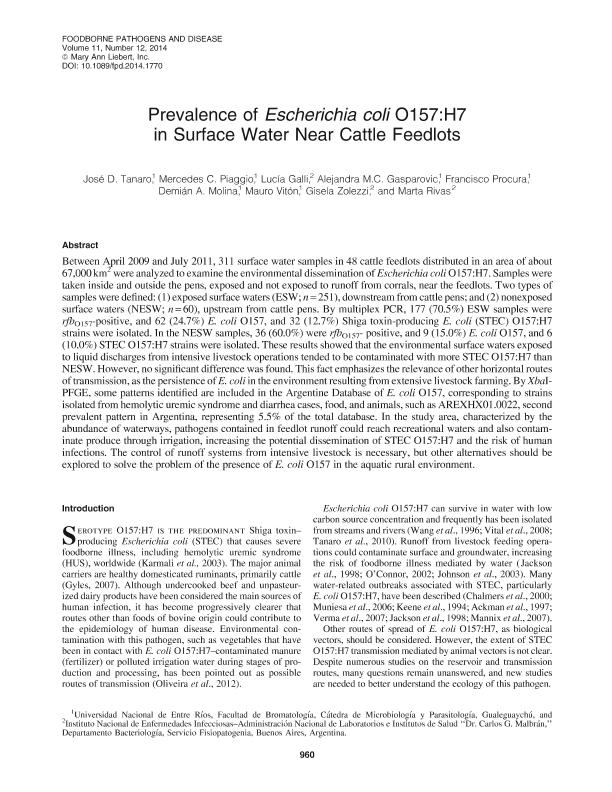Artículo
Prevalence of Escherichia Coli O157:H7 in surface water near cattle feedlots
Tanaro, José Daniel; Piaggio, Mercedes Carolina; Galli, Lucía ; Gasparovic, Alejandra M. C.; Procura, Francisco
; Gasparovic, Alejandra M. C.; Procura, Francisco ; Molina, Demián A.; Vitón, Mauro; Zolezzi, Gisella; Rivas, Marta
; Molina, Demián A.; Vitón, Mauro; Zolezzi, Gisella; Rivas, Marta
 ; Gasparovic, Alejandra M. C.; Procura, Francisco
; Gasparovic, Alejandra M. C.; Procura, Francisco ; Molina, Demián A.; Vitón, Mauro; Zolezzi, Gisella; Rivas, Marta
; Molina, Demián A.; Vitón, Mauro; Zolezzi, Gisella; Rivas, Marta
Fecha de publicación:
08/2014
Editorial:
Mary Ann Liebert Inc
Revista:
Foodborne Pathogens And Disease
ISSN:
1535-3141
e-ISSN:
1556-7125
Idioma:
Inglés
Tipo de recurso:
Artículo publicado
Clasificación temática:
Resumen
Between April 2009 and July 2011, 311 surface water samples in 48 cattle feedlots distributed in an area of about 67,000 km2 were analyzed to examine the environmental dissemination of Escherichia coli O157:H7. Samples were taken inside and outside the pens, exposed and not exposed to runoff from corrals, near the feedlots. Two types of samples were defined: (1) exposed surface waters (ESW; n = 251), downstream from cattle pens; and (2) nonexposed surface waters (NESW; n = 60), upstream from cattle pens. By multiplex PCR, 177 (70.5%) ESW samples were rfbO157-positive, and 62 (24.7%) E. coli O157, and 32 (12.7%) Shiga toxin-producing E. coli (STEC) O157:H7 strains were isolated. In the NESW samples, 36 (60.0%) were rfbO157- positive, and 9 (15.0%) E. coli O157, and 6 (10.0%) STEC O157:H7 strains were isolated. These results showed that the environmental surface waters exposed to liquid discharges from intensive livestock operations tended to be contaminated with more STEC O157:H7 than NESW. However, no significant difference was found. This fact emphasizes the relevance of other horizontal routes of transmission, as the persistence of E. coli in the environment resulting from extensive livestock farming. By XbaIPFGE, some patterns identified are included in the Argentine Database of E. coli O157, corresponding to strains isolated from hemolytic uremic syndrome and diarrhea cases, food, and animals, such as AREXHX01.0022, second prevalent pattern in Argentina, representing 5.5% of the total database. In the study area, characterized by the abundance of waterways, pathogens contained in feedlot runoff could reach recreational waters and also contaminate produce through irrigation, increasing the potential dissemination of STEC O157:H7 and the risk of human infections. The control of runoff systems from intensive livestock is necessary, but other alternatives should be explored to solve the problem of the presence of E. coli O157 in the aquatic rural environment.
Palabras clave:
Escherichia Coli O157
,
Cattle
,
Manure
,
Pre-Harvest Food Safety
Archivos asociados
Licencia
Identificadores
Colecciones
Articulos(IGEVET)
Articulos de INST.DE GENETICA VET ING FERNANDO NOEL DULOUT
Articulos de INST.DE GENETICA VET ING FERNANDO NOEL DULOUT
Citación
Tanaro, José Daniel; Piaggio, Mercedes Carolina; Galli, Lucía; Gasparovic, Alejandra M. C.; Procura, Francisco; et al.; Prevalence of Escherichia Coli O157:H7 in surface water near cattle feedlots; Mary Ann Liebert Inc; Foodborne Pathogens And Disease; 11; 12; 8-2014; 960-965
Compartir
Altmétricas



